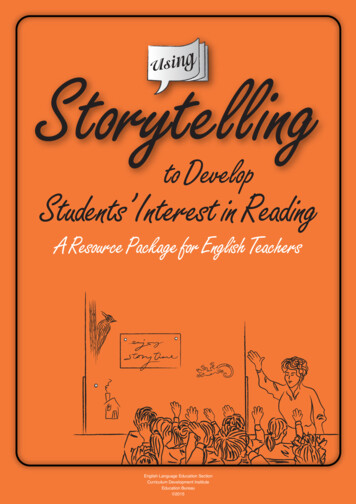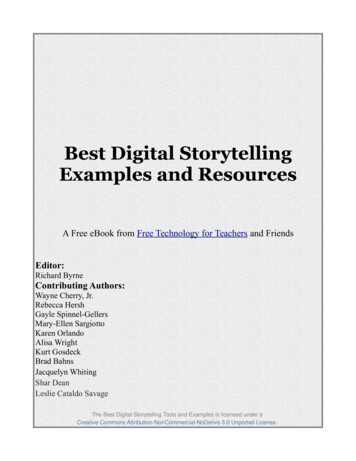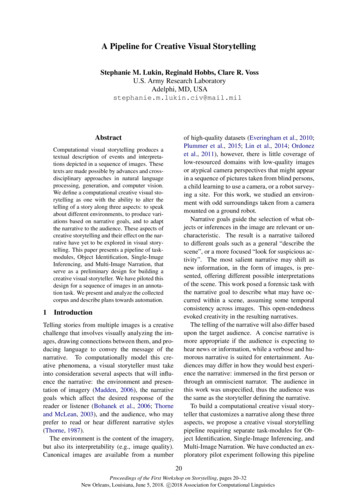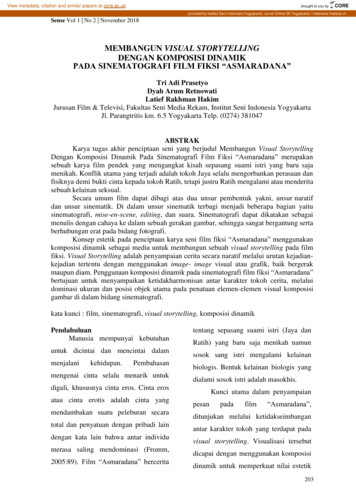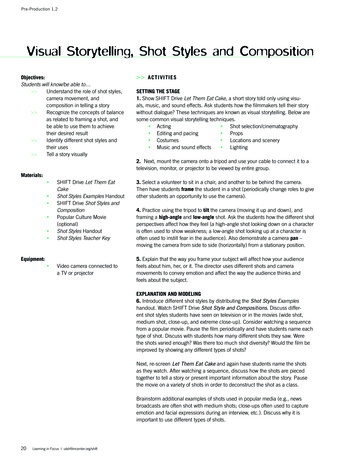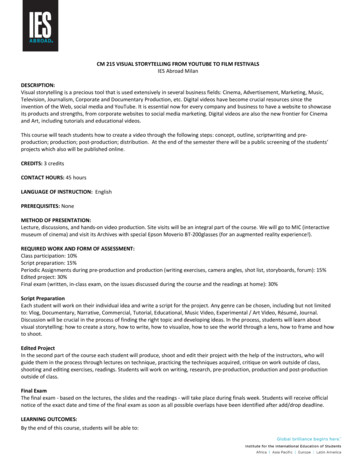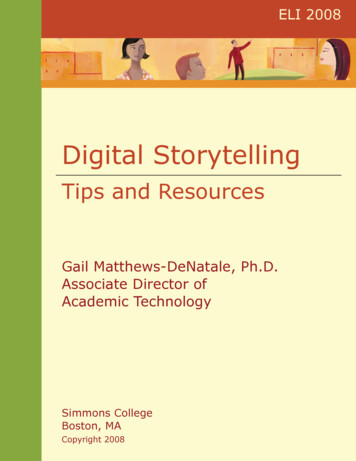
Transcription
Therapeutic Applications ofMetaphorical StorytellingAdvancing School Mental HealthSaturday November 9, 2019Michael E. Woolley, MSW, DCSW, Ph.D.Associate Professor, School of Social WorkUniversity of Maryland, Baltimore
Workshop Goals Discuss two approaches to the use ofmetaphorical storytelling in clinical work withchildren Review examples of both storytelling techniques,then try both based on case vignettes in smallgroups If you already use storytelling, hopefully you willfind a couple new ideas to add to your tool kit If you don’t, the central goal is for you to gain theknowledge and confidence to give this techniquea try
Why do most practice models usePlay in clinical work with Children? Play is how children rehearse andlearn how to be adults Play is the language of childhood, it ishow children: process experiences,express feelings, seek understanding,gain mastery Play processes can be metaphors
Metaphors Definition: “Something used to represent orsymbolize something else” From Latin “metaphora” - to transfer, carryover; change, alter Through French “metaphore” – a word,phrase, or image used as a symbol torepresent something else Metaphors have been used in clinical workfor many years in different forms “A zipped folder with words .”
Metaphorical Storytelling: Play with Words Universal: Metaphorical Stories have beenused to teach and influence children acrosscultures and time: Greek Mythology, Fables,Holy Books, Shamans Speaks their language and engages childrenin a multidimensional way: emotionally,cognitively, creatively Ugly Duckling; Boy Who Cried Wolf; Tortoiseand Hare; Ant & Grasshopper
Why Metaphorical Storytelling? Developmental Fit Taps into the same processing andcommunication capacities of play Metaphorical play is how children express,process, and gain mastery Works around verbal and cognitive processinglimitations Messages the social worker sends are muchmore likely to be “heard” Portable and Adaptable: Don’t need toys or aplay room
The Brain and Processing Metaphors Right Brain Left Brain Right brain develops first Children can process experiences, emotions,trauma, struggles, and conflicts metaphoricallymore effectively and sooner than they canprocess them verbally Metaphorical storytelling process: The structureof the metaphorical story connects to the reality structure it represents, then the messages you embed in the metaphor getconnected to the child’s life experiences andreactions
Why does this work? Avoids triggering: child anxiety, fear,shame, embarrassment, family dynamicsaround secrets and boundaries “resistance” Sidesteps defenses built up about adultscorrecting, punishing, confronting, shaming Child does not have to admit, divulge,reveal, share, confess, disclose, concede It can be Fun and engaging – SWCI – forthe child and for us
What can Storytelling Do? Communicateempathy Affirm feelings orthoughts Reframe problem Provide information Capitalize onstrengths Create alternatives Teach coping skills Facilitate insight Normalize feelingsor thoughts Offer healthierresponses orbehaviors Suggest moremature coping oradaptation
When and with Whom? Children 4 to 12 Children, Adolescents, Classrooms,Families Clients who will not talk, or “resistant” youth Cognitively delayed clients of any age Any setting and most situations Cautions: Thought D/O, Autism SpectrumD/O
Preparing to use Storytelling1. Get to know the child: struggle(s) and lifesituation2. Identify a struggle, problem, or situation youwant to address metaphorically (in yourfirst story)3. Identify a message you want to send withthe metaphorical story: empathy,affirmation, you “get it”, interventions,insights4. Typically, tell the story at the end of thesession
Designing Therapeutic Stories Chose the characters The main character is the child Animals: choose a main character that reflect thechild’s interests and/or has metaphorical meaning Consider Humans for older children/teens What other characters do you need? Consider personifying trauma, conflict, struggles ascharacters Chose a setting: That will appeal to and be engaging to the child The setting can also serve a role in the metaphor “Once upon a time, in a place, far, far away .” “deep in abeautiful forest ” “in a pond in the middle of a hugemeadow .”
Telling Therapeutic Stories1. Set a stage: describe the broad setting, alittle acting helps here 2. Introduce the main character3. Add characters to represent importantpeople in the child’s life in relation to thesituation or issues being addressed4. Consider personifying critical processesas characters
Telling Therapeutic Stories5. Establish the metaphoricalrepresentation of the problem,struggle, issue, or conflict in the child’slife that will be the focus of the story6. Develop the action among thecharacters as the metaphoricalconflict, struggle, or dilemma unfolds7. Consider creating a crisis or dilemmafor the main character
Constructing Therapeutic Stories8. Communicate your message in the story9. Have the story come to a stopping pointa. Do not try to fix it all in one storyb. Assume this is the first of a series of storiesc. One message at a time10. Consider offering a title or theme for the story(or ask the child about what that might be)
Storytelling Example:Running Away
Group Exercise
Mutual Storytelling Technique1) Set up situation where you get thechild to tell you a story she or hemakes up2) Analyze the story the child tells3) Construct and tell the child a storyback that starts with the Child’smetaphors then you add atherapeutic message
Getting the Child’s Story1) Introduce as a storytelling show game2) Show child the microphone/recorder andask if child wants to play3) (note: get informed consent from parentsand assent from child to audio record)4) If “OK” start recorder and begin the“Storytelling Show”5) Intro yourself as the Host, the Show, theChild, and overall process
6) Detail the rules for the storiesa. The “story has to be one the guest made up”, notone from “TV, a book, movie, or a video game”b. Good if story has: “beginning, middle and an end”c. It is also good if the story has a theme, title, orlesson10) “And now let me introduce our special guest .” –(hold the microphone for the child)11) Help child start if they struggle to get started,“Once upon a time .” hold mic to Child12) Prompt “and then” “wow, what happens next”“what do they do now”13) Prompt child until she/he asserts they are done orstory seems complete
14. When story is over, ask for title, lesson,theme, etc.15. Analyze child’s story16. Offer to listen to child’s story17. Construct your story18. Tell child your story19. Record your story as well20. Offer to listen to whole recording again,leave it up to the child
Analyzing the Child’s Story Think about what you know about the childand family, and presenting struggle(s) Family-school dynamics Who or what do the other charactersrepresent? (child, family, teachers, friends,you, etc.) What is the overall feel or affect? What is the major conflict or struggle? Separate atypical or unique to the childfrom derivative Factor in child’s theme or lesson
Construct a Therapeutic Story1) Use the child’s characters, setting,situation, and story beginning2) Decide what your intervention goal will bea) Communicate empathy that you “get it”b) Reflect affect of characters: pain, fear,anxiety, anger, ragec) Provide information, reframe, or help thechild understand the situationd) Suggest a healthier, more adaptive,developmentally appropriate response orstrategy
Construct Therapeutic Story3) Do you need to add characters?4) When will you deviate from the child’sstory?5) What will be the new ending?6) Use your theme, title or lesson toemphasize your message
After you tell your story Offer to listen to recording again, from thebeginning. If child says “I am the bear aren’t I?” respondwith interest, curiosity about what the child issaying, uncertainty and/or surprise. However, avoid interpreting the child’s oryour story, let the child own the metaphorand the interpretation of the metaphor
Mutual Storytelling Example:The Guys in the Creepy DarkWeird Place
Group Exercise
DiscussionQuestions?Comments?
ResourcesBecvar, D. S., & Becvar, R. J. (1993). Storytelling in family therapy. American Journal of FamilyTherapy, 21, 2, 145-160.Brandell, J. R. (2016). Of Mice and Metaphors: Therapeutic Storytelling with Children. ThousandOaks, CA: Sage Publications.Burns, G. W. (2001). 101 Healing Stories: Using Metaphors in Therapy. New York: Wiley and Sons.Cook, J. W. & Taylor, L. A., & Silverman, P. (2004). The application of therapeutic storytellingtechniques with preadolescent children: A clinical description with illustrative case study.Cognitive and Behavioral Practice, 11, 243-248.Early, B. P. (1993). The healing magic of myth: Allegorical tales and the treatment of children ofdivorce. Child and Adolescent Social Work Journal, 10, 2, 97-106.Gardner, R. A. (2002). Mutual Storytelling. In C. E. Schaefer and D. Cangelosi (Eds.), Play TherapyTechniques. Jason Aronson: Northvale, NJ.Gardner, R. A. (1971). Therapeutic Communication with Children: The Mutual StorytellingTechnique. New York: Aronson.Mills, J. C., & Crowley, R. J. (1986). Therapeutic Metaphors for Children and the Child Within. NewYork: Bruner-Mazel.Parker, T. S. & Wampler, K. S. (2006). Changing emotion: The use of therapeutic storytelling.Journal of Marital and Family Therapy, 32, 2, 155-166.Reichert, E. (1998). Individual counseling for sexually abuse children: A role for animals andstorytelling. Child and Adolescent Social Work Journal, 15, 3, 177-185.Slivinske, J. & Slivinske, L. (2016). Therapeutic Storytelling for Adolescents and Young Adults.Youngstown, OH: Oxford University Press.Smith, G. G. & Celano, M. (2000). Revenger of the mutant cockroach: Culturally adaptedstorytelling in the treatment of a low-income African American boy. Cultural Diversity andEthnic Minority Psychology, 6, 2, 220-227.
Therapeutic Storytelling for Adolescents and Young Adults. Youngstown, OH: Oxford University Press. Smith, G. G. & Celano, M. (2000). Revenger of the mutant cockroach: Culturally adapted storytelling in the treatment of a low-income African American boy. Cultural
